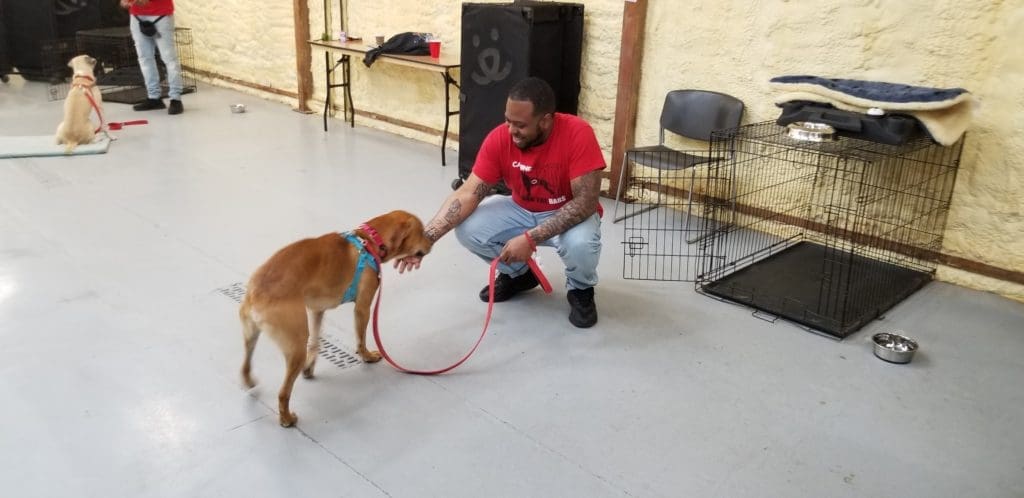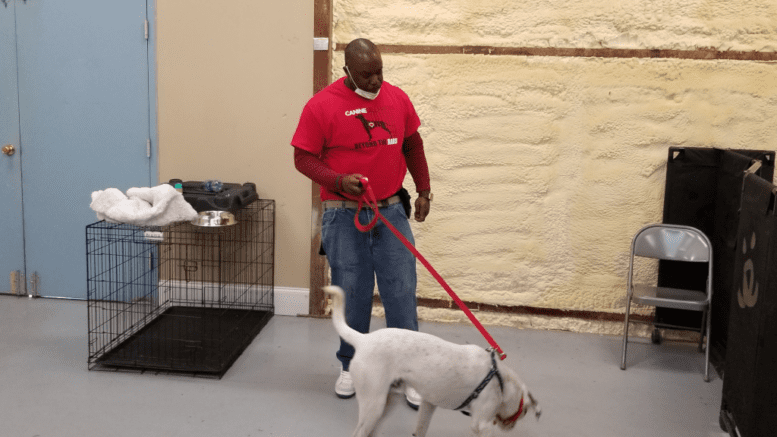Canine CellMates is a program that pairs men caught up in the criminal justice system with rescue dogs, and teaches the participants to train the dogs.
The Smyrna-based organization has launched a new initiative in partnership with the Fulton County District Attorney’s office.
The partnership is called Beyond the Bars, a pre-trial diversion and sentencing alternative program. Canine Cellmates Executive Director Susan Jacobs-Meadows said she believes this is the first program of its type in the United States. It’s part of a trend away from purely punitive approaches toward criminal justice, and toward programs that provide alternatives to incarceration.
The program also counsels the men in skills needed to avoid incarceration, and upon successful completion of the program, the legal proceedings against them will be terminated, similar to the outcome of successful program completion in Cobb County’s Accountability Courts.
Before conducting a tour of the facility Jacobs-Meadows introduced Gremlin, a puppy that will be brought into the program in January.

She said that each incoming class has a naming theme for the dogs.
“For this group of dogs the theme Is car models,” she said. “So we have Blazer, and Bronco, and Rio, and Sierra, and Tundra, and Shelby … so his name is Gremlin.”
Jill Hollander, a prosecutor with the Fulton County DA’s office in the Animal Cruelty & Elder Abuse Unit, was on hand during the inauguration of the program.
The Courier asked her what the proper terminology is for the participants in the program from the standpoint of the criminal justice system.
Hollander said that since the participants are brought into the program from several different points in the prosecution process, from pre-trial to probation, she calls their status “alternative disposition.”
Jacobs-Meadows said that within the program, “participants” is the preferred term.

She said that Canine CellMates was formed in 2013, and at that time was based in the Fulton County jail.
She said that during their time at the jail over 400 men went through the program, and 150 shelter dogs were trained and adopted into families.
When COVID-19 shut down the jail-based program, the organization worked on restructuring and moving into their current building, which they secured by getting a large grant from Best Friends Animal Society, who were the previous occupants of the Smyrna space.
Best Friends is one of the largest animal rescue organizations in the country, and they decided to change directions from a facility-based organization to one focused on foster-based rescues.
So that made the South Atlanta Road facility available.
Canine CellMates began moving in May of this year.

Jacobs-Meadows said that the focus of Canine CellMates has always been on the participants and that it is a rehabilitative program, and not a vocational training program.
She said that “we would not be here except for the District Attorney’s office taking a new slant on how cases get disposed, and so they have to approve them first.”
After the DA’s office approves a prospective participant, Jacobs-Meadows interviews them to determine if they are a good fit for the program.
“And then we run much like an accountability court,” she said. “There’s an intensive phase in the beginning, so the men come here four half days a week. For the first 90 days, it’s a pretty big commitment.”
“They have to have stable housing, I wish we had the option to offer that for them. And we would love to have our own housing facility. But we don’t have that yet,” Jacobs-Meadows said. “So they have to have stable housing.”
“During the time that they’re here, they work with rescue dogs in a group training environment much like the program that we run (at the jail),” she said. “They do some helping to care for the dogs in the buildings and washing the runs and setting up and cleaning up and those kinds of things.”
“And then they also sit in curriculum,” she said.
“We started with conflict resolution. And then we did emotional competence (and) parenting skills,” Jacobs-Meadows said. “Yesterday, we started with effective communication. And the final two weeks of the curriculum will be ‘Staying out of jail 101’, which has to do with decision making and goal setting.”
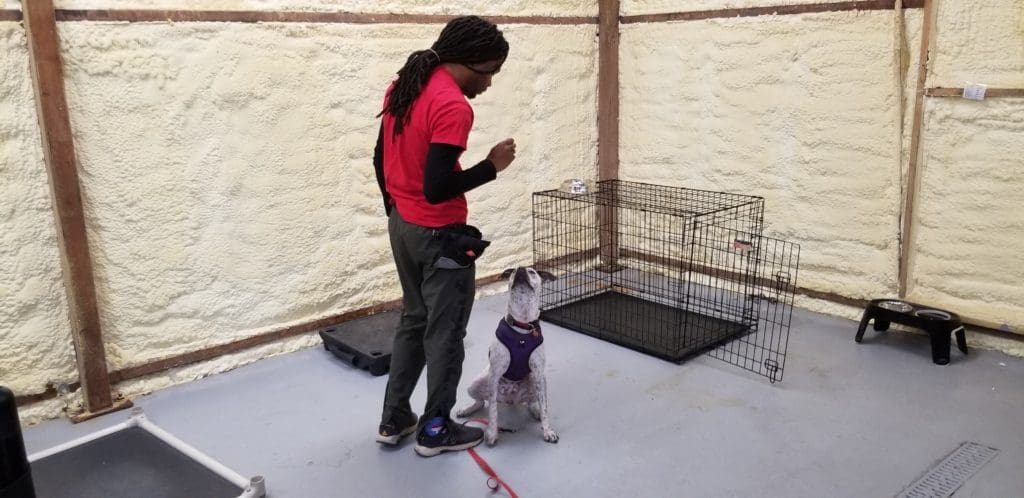
She said that graduation will be held, and the dogs will be ready for adoption at that point.
The participants will then move on to phase two, which will involve group sessions.
The time commitment of the participants will diminish as they reach the end of the program. In the end, if they document stable employment or enrollment in an educational program, the court proceedings against them will be terminated.
Jacobs-Meadows conducted a tour around the building and provided introductions to a few dogs with special needs who were not yet in the training program.
She said that the program uses no aversive training methods, and said that those methods can change behavior temporarily, but the dogs just think “Oh, well, they’re looking. So I’m not gonna do that.”
The participants instead teach the animal with the use of a clicker, straightforward commands always using the same tone of voice, and treats as rewards.
Back in the training area participants demonstrated the method.
Sierra, trained by participant Sanwan, was ignoring the touring group and was completely focused on her work while Sanwan gave a command along with a click, and threw a treat to her when she carried out the task.
When the training ended Sierra got very friendly with the people around her.
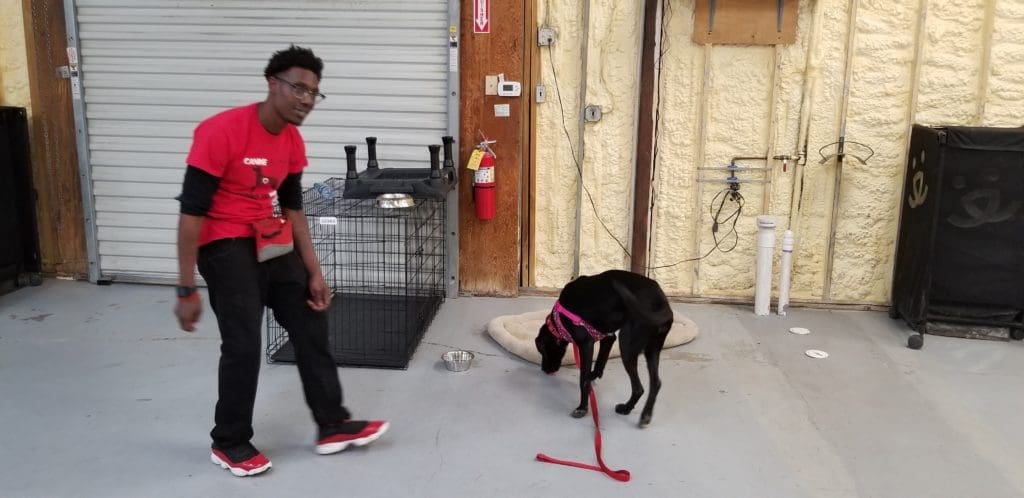
Sanwan said he had been training Sierra, a black lab, for about two months.
The Courier asked if she had learned quickly.
“Since day one,” he said. “It doesn’t take probably the first five minutes for her to get what it is you’re trying to get her to do.”
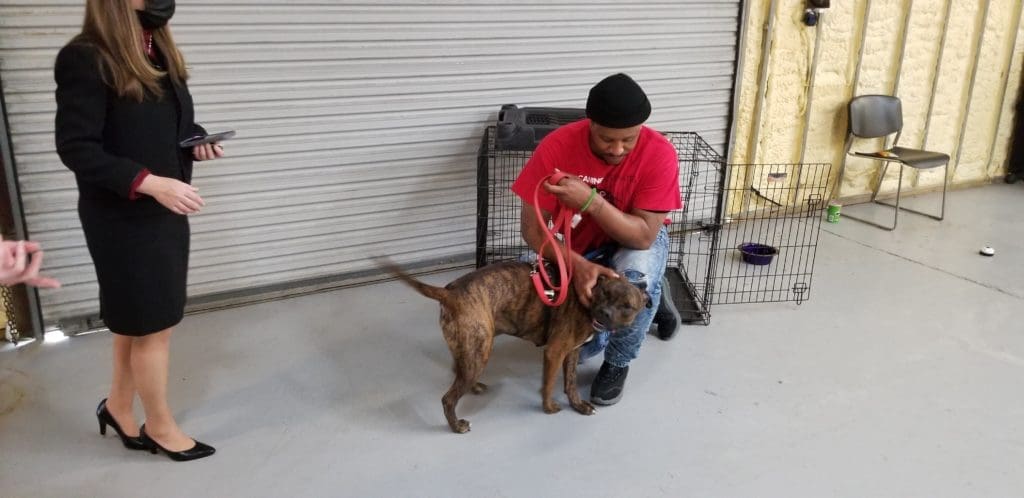
Quartez said that his dog, Zephyr, was also a fast learner. “As soon as you use a clicker, and show him what you want him to do, he pretty much picks up on it. You have to lead him through.”
The Courier asked him what a typical day looks like in the program.
“We have fun,” he said. “We enjoy ourselves. We learn how to train the dogs.”
“We learn how to deal with anger management, coping skills, communication skills, fatherhood …,” he said.
The Courier asked Hollander why the Fulton DA’s office is involved in Beyond the Bars.
“The Fulton County District Attorney’s office is committed to serving justice with integrity,” she said. “And what that requires of us is that we look at not just the circumstances of the crime, but the person that is behind it and the circumstances …”
“This program allows us to take some individuals who otherwise we would have no choice but to incarcerate and offer them an opportunity to make a positive change in their life,” she said. “This program allows them to learn some of the behaviors that they have adopted in their daily lives have not necessarily been the best ones.”
“This program offers them the ability to learn how to better handle that conflict, and other circumstances in their lives that would cause them to make bad choices, or the not best choice, which led them to involvement in the criminal justice system, by learning different ways to learn, handle circumstances that they find in their lives.”
“Through working with the dogs and learning conflict resolution, learning that there are ways to handle a circumstance other than through violence, threats, force or intimidation, we hope that they will be able to become better equipped to handle their life and become a better person,” Hollander said.
